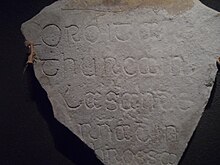Middle Irish
| Middle Irish | |
|---|---|
| Middle Gaelic | |
| Gaoidhealg | |
| Pronunciation | [ˈɡəiðeɫɡ] |
| Native to | Ireland, Scotland, Isle of Man |
| Era | Circa 900–1200 |
Indo-European
| |
Early forms | |
| Latin (Gaelic alphabet) | |
| Language codes | |
| ISO 639-2 | mga |
| ISO 639-3 | mga |
| Glottolog | midd1360 |
Middle Irish, sometimes called Middle Gaelic[1] (Irish: An Mheán-Ghaeilge),[2] is the Goidelic which was spoken in Ireland, most of Scotland and the Isle of Man from c. 900–1200 AD; it is therefore a contemporary of late Old English and early Middle English.[3][4] The modern Goidelic languages—Irish, Scottish Gaelic and Manx—are all descendants of Middle Irish.
The Lebor Bretnach, the "Irish Nennius", survives only from manuscripts preserved in Ireland; however, Thomas Owen Clancy has argued that it was written in Scotland, at the monastery in Abernethy.[5]
Grammar[]
Middle Irish is a fusional, VSO, nominative-accusative language.
Nouns decline for two genders: masculine, feminine, though traces of neuter declension persist; three numbers: singular, dual, plural; and five cases: nominative, accusative, genitive, prepositional, vocative. Adjectives agree with nouns in gender, number, and case.
Verbs conjugate for three tenses: past, present, future; four moods: indicative, subjunctive, conditional, imperative; independent and dependent forms. Verbs conjugate for three persons and an impersonal, agentless form (agent). There are a number of preverbal particles marking the negative, interrogative, subjunctive, relative clauses, etc.
Prepositions inflect for person and number. Different prepositions govern different cases, depending on intended semantics.
Example[]
The following is a poem in Middle Irish about Eógan Bél, King of Connacht.[8]
Dún Eogain Bél forsind loch forsrala ilar tréntroch,
ní mair Eogan forsind múr ocus maraid in sendún.
Maraid inad a thige irraibe ’na chrólige,
ní mair in rígan re cair nobíd ina chomlepaid.
Cairptech in rí robúi and, innsaigthech oirgnech Érenn,
ní dechaid coll cána ar goil, rocroch tríchait im óenboin.
Roloisc Life co ba shecht, rooirg Mumain tríchait fecht,
nír dál do Leith Núadat nair co nár dámair immarbáig.
Doluid fecht im-Mumain móir do chuinchid argait is óir,
d’iaraid sét ocus móine do gabail gíall [n]dagdóine.
Trían a shlúaig dar Lúachair síar co Cnoc mBrénainn isin slíab,
a trían aile úad fo dess co Carn Húi Néit na n-éces.
Sé fodéin oc Druimm Abrat co trían a shlúaig, nísdermat,
oc loscud Muman maisse, ba subach don degaisse.
Atchím a chomarba ind ríg a mét dorigne d’anfhír,
nenaid ocus tromm ’malle, conid é fonn a dúine.
Dún Eogain.
References[]
- ^ Mittleman, Josh. "Concerning the name Deirdre". Medieval Scotland. Retrieved 13 February 2013.
Early Gaelic (a.k.a. Old Irish) is the form of Gaelic used in Ireland and parts of Scotland from roughly 600–900 AD. Middle Gaelic (a.k.a. Middle Irish) was used from roughly 900–1200 AD, while Common Classical Gaelic (a.k.a. Early Modern Irish, Common Literary Gaelic, etc.) was used from roughly 1200–1700 AD
- ^ "Middle Irish". www.uni-due.de.
- ^ Mac Eoin, Gearóid (1993). "Irish". In Martin J. Ball (ed.). The Celtic Languages. London: Routledge. pp. 101–44. ISBN 0-415-01035-7.
- ^ Breatnach, Liam (1994). "An Mheán-Ghaeilge". In K. McCone; D. McManus; C. Ó Háinle; N. Williams; L. Breatnach (eds.). Stair na Gaeilge in ómós do Pádraig Ó Fiannachta (in Irish). Maynooth: Department of Old Irish, St. Patrick's College. pp. 221–333. ISBN 0-901519-90-1.
- ^ Clancy, Thomas Owen (2000). "Scotland, the 'Nennian' recension of the Historia Brittonum, and the Lebor Bretnach". In Simon Taylor (ed.). Kings, Clerics and Chronicles in Scotland, 500-1297. Dublin & Portland: Four Courts Press. pp. 87–107. ISBN 1-85182-516-9.
- ^ Healy, John (8 June 2016). Insula Sanctorum Et Doctorum Or Ireland's Ancient Schools And Scholars. Read Books Ltd. ISBN 9781473361331 – via Google Books.
- ^ "CISP - CLMAC/13". www.ucl.ac.uk.
- ^ "A Middle Irish Poem on Eogan Bél [text]". www.ucd.ie.
Further reading[]
- MacManus, Damian (1983). "A chronology of the Latin loan words in early Irish". Ériu. 34: 21–71.
- (1978). "The dative singular of Old Irish consonant stems". Ériu. 29: 26–38.
- McCone, Kim (1981). "Final /t/ to /d/ after unstressed vowels, and an Old Irish sound law". Ériu. 31: 29–44.
- McCone, Kim (1996). "Prehistoric, Old and Middle Irish". Progress in medieval Irish studies. pp. 7–53.
- McCone, Kim (2005). A First Old Irish Grammar and Reader, Including an Introduction to Middle Irish. Maynooth Medieval Irish Texts 3. Maynooth.
See also[]
| For a list of words relating to Middle Irish, see the Middle Irish language category of words in Wiktionary, the free dictionary. |
- Languages attested from the 10th century
- History of the Irish language
- Medieval languages
- Scottish Gaelic language
- Culture of medieval Scotland
- Medieval Ireland
- Manx language

